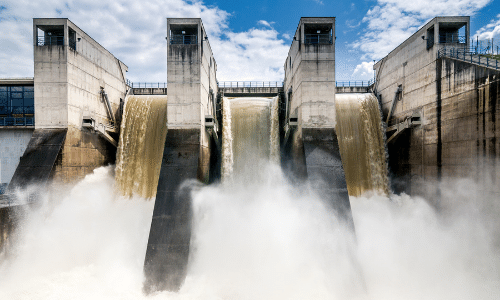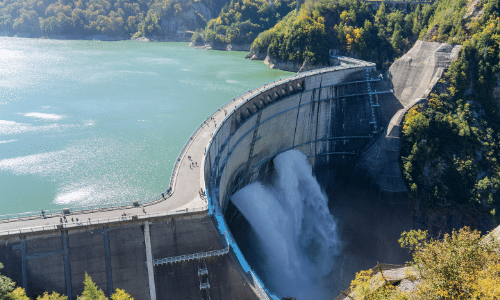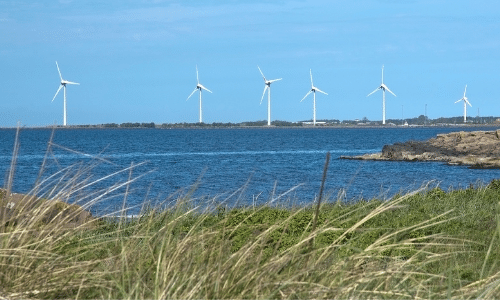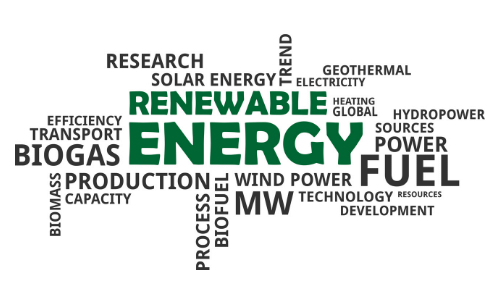One of the oldest forms of renewable energy is hydropower. Water wheels have been used for centuries to run mills, providing mechanical power directly to heavy machinery through rotating shafts.
The leap from mechanical power to hydroelectricity was a small one once engineers understood the relationship between electricity and magnetism.
So how does a hydroelectric generator work?
Renewable Energy Simplified
But before that, what is renewable energy? Renewable energy refers to the energy from natural resources such as wind, water, solar, biomass, and geothermal heat. It’s called renewable energy because we can quickly replenish and not waste it when we use it. In theory, it will never run out.
In this example, when we use water to generates electricity, we get electricity, and we don’t waste the water.
How Hydropower and Hydroelectric Systems Work

In its simplest form, moving water turns a wheel. A shaft or belt connects the wheel to a generator, which is just a fancy term for a loop of conductive wire in the field of a strong magnet.
As the loop of wire rotates, the magnetic field pushes the electrons in the coil of wire first in one direction and then the other. And voila, you have alternating current!
Easy right?
The above is a dramatic simplification of the process. Modern generators have a lot more copper wire than a simple loop. There are usually multiple magnets with special housings to concentrate the windings’ magnetic field where it will have the most substantial effect.
There are also control loops with speed sensors, current and voltage detectors, and countless other gadgets designed to ensure that the generator’s electricity conforms to the local utility grid’s standards.
Storage projects
Most utility-scale hydroelectric projects use dams to impound water in a reservoir, which is why they are sometimes called storage projects. The high head pressures built up behind these enormous dams will drive the large-scale hydro turbines.
Hydroelectricity generators this size have capacities numbering in the hundreds of megawatts. They can be dispatched quickly in response to spikes in demand.
Since they store large volumes of water in their dams, their output is relatively insensitive to river level changes caused by storms or run-off. But they are sensitive to extended precipitation irregularities, like year-long droughts.

How The Electric Utility Grid Functions?
To understand the difference between traditional storage and pumped hydroelectric storage systems, you first must know a little about how the electric utility grid functions.
When you connect your laptop to the outlet in your home, it is a consumer of electricity. When you join a generator to the other end of the grid, it is the electricity producer or a source.
The goal of the electric utility companies that own and operate the grid is to keep producers and consumers in balance at all times. It’s an actual juggling act.
There is a spike in demand on hot summer afternoons when people come home from work and crank up their air conditioning. The utility grid must be able to respond to this sudden surge by turning on more generators. Likewise, when everyone goes to bed and turned off all the lights and appliances, there is a demand drop. Then the electric utilities have to idle the generators they brought online to respond to the surge.
There are also short-duration spikes on top of these relatively predictable daily and seasonal variations in demand. Due to sudden local weather changes, damage to transmission systems, generator production fluctuation will cause these short-duration spikes. It’s enough to have a utility manager pulling their hair out.
The spike is what people are referring to when they talk about peak power or peaking capacity plants.
Hydroelectric generators make excellent peaking plants since they can react quickly in response to surges in demand. Hydroelectric power stations are arguably the most dispatchable of the renewable energy technologies available.
Pumped storage projects
Pumped storage projects are specialized hydroelectric peaking plants. In addition to the standard reservoir above the turbines, a pumped storage project will have a second storage reservoir or a lake below the turbines. When electricity requirement is low, electricity is taken from the grid to pump water from the lower reservoir into the upper one. When requirement is high, the upper pool drains into the lower reservoir through the turbines, supplying electricity back to the grid.
Pumped storage projects are net energy consumers: It takes more energy to pump the water uphill than you get from letting it flow back down again. But utility companies can use pumped storage projects to displace peak demand. And if you combine pumped storage with a non-dispatchable renewable energy source like wind, it can be a winning combination.

Renewable Energy In Malaysia
Natural gas-fired and coal generate most of the electricity in Malaysia. But in recent years, we have seen that the government is reducing its dependency on fossil fuels. Malaysia is moving to renewable energy sources.
We also see more renewable energy plants, especially hydropower plants. The 2,400 MW Bakun plant in Sarawak, opened in 2011, is the largest hydropower plant in Malaysia. Then we have the 944 MW Murum plant, also in Sarawak, which opened in 2015. There’s also the 1,285 MW Baleh plant which is still under construction.
Once the Baleh plant is online, renewable energy will contribute 60% of Sarawak’s electricity. We hope to see the same percentage of renewable energy in Peninsular Malaysia.
Water power had been around almost as long as the wheel, and it looks like it will remain a part of our world’s energy solutions for a long time to come.




